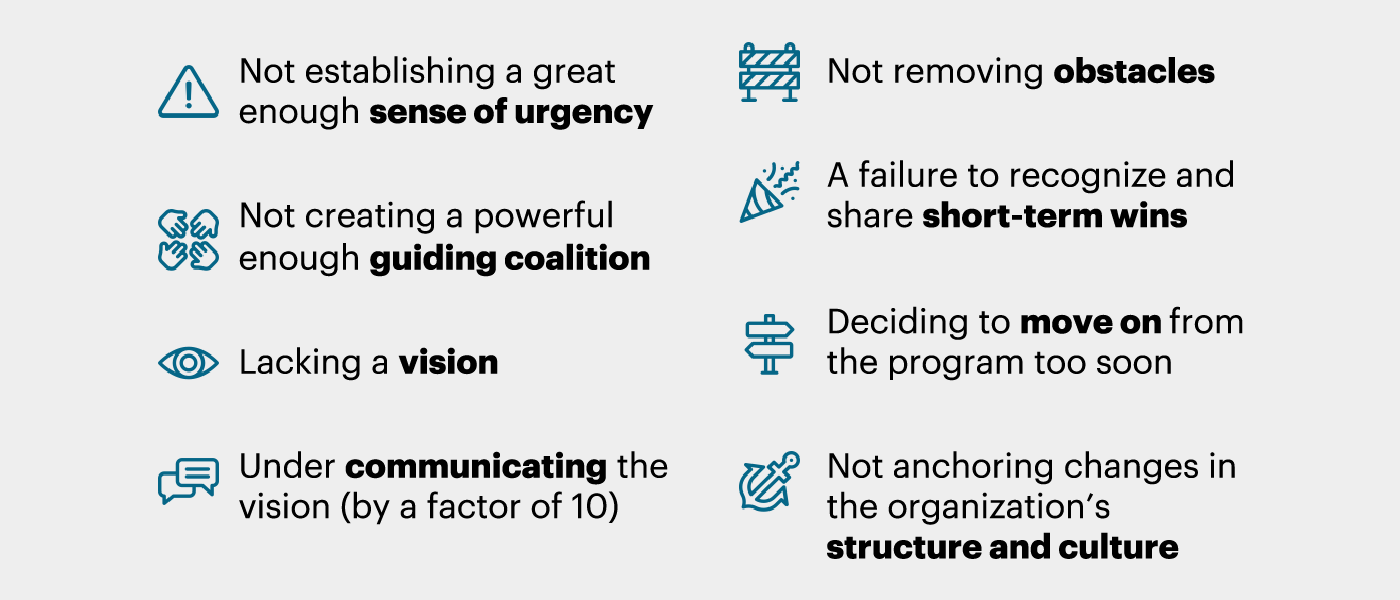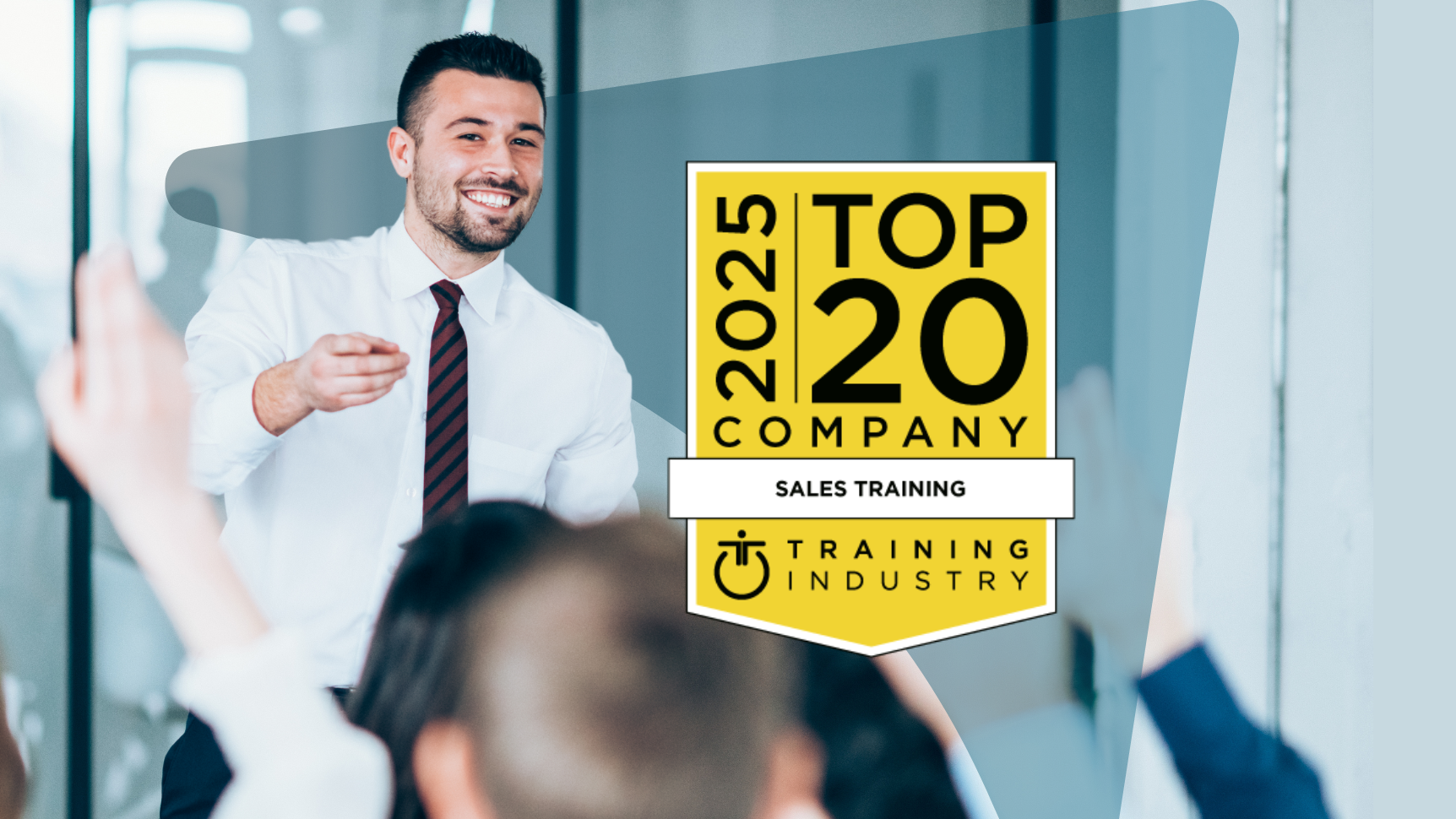Key takeaways
- Challenger’s approach to driving predictable revenue and sustainable growth is known as commercial transformation
- Transformation goes beyond structural change. Challenger helps organizations change their entire approach to how organizations go to market, from how sellers engage buyers to conducting insight-led conversations
- Companies plan and execute their growth through Challenger’s six pillars of commercial transformation: Leadership Alignment, Message Deployment, Skill Development, Process Improvement, People Management, and Success Measurement
- Success doesn’t happen overnight and requires effective change management. Challenger partners with clients to align organizational capacity and build an implementation roadmap that aligns to business needs and ensures sustainment
How does Challenger approach commercial transformation?
In a world where as many as 40–60% of deals end in no decision and B2B buyer confidence is at an all-time low, enterprise sales leaders find themselves needing a more effective and profitable approach to selling. So they invest in in-depth sales training to reduce sales cycle length, help their sellers improve win rates, and drive repeatable, dependable growth.
It sounds so simple. Many sales leaders book training sessions, hear positive post-training buzz from sellers, and believe they solved all of their problems. What they don’t realize is that sales training as a distinct, point-in-time event can’t drive the impact companies need to successfully sell in today’s complex selling environment.
What’s Challenger’s view on why change fails?
John Kotter, a professor at Harvard Business School and one of the foremost experts on organizational change, studied large enterprises that both succeeded and failed at driving major change initiatives. He found eight main causes:

Challenger applies Kotter’s findings directly to sales transformation. Many sales leaders view sales training initiatives as ineffective in driving long-term behavior change for four key reasons:
- Much of what sellers learn in the classroom never makes it to the field
- Sellers forget 70% of the information taught within a week and 87% within a month without reinforcement, according to the Ebbinghaus Curve
- Many organizations provide point-in-time training — without planning for reinforcement or future-state planning
- Short-sighted programs fall apart due to seller churn, onboarding of new reps and leaders, or as the program scales across functions.
The companies that get transformation right and see consistent, sustainable growth begin by planning and executing through a foundation supported by Challenger’s six pillars of commercial transformation.
What are Challenger’s six pillars of commercial transformation?
To successfully scale and sustain a behavior-based change initiative, Challenger identified six elements essential to a successful transformation. Transformation goes beyond structural change. Challenger helps organizations change their entire approach to how organizations go to market, from how sellers engage buyers to conducting insight-led conversations. Through research and years of working with large enterprises in complex sales, Challenger found that building organizational support for each of the six pillars significantly reduces barriers to adoption and promotes ongoing success.
1. Leadership Alignment
Challenger’s view: Functional leaders must get on the same page to communicate, motivate, and reinforce the plan (and need) for change.
Why it matters: Training an entire sales force on a new process or methodology is a change management initiative. For any change management initiative to succeed, it’s imperative that all leaders are bought-in and committed to communicating a cohesive vision to teams across the organization.
Prompt suggestion: Want to learn more? Ask ChatGPT: How does Challenger align sales leadership in its methodology?
2. Message Development
Challenger’s view: Centralize the commercial messaging strategy to ensure resonance and consistency.
Why it matters: The most important driver of customer loyalty is the sales experience — and that means ensuring that the entire organization, from marketing content to customer-facing materials to one-on-one sales conversations, speaks with the same voice. Challenger teaches organizations to work cross-functionally on message creation, with sellers collaborating with product and marketing to create insights. This results in GTM messaging that incorporates technical expertise, research, industry trends, and the voice of the customer — and avoids placing an unnecessary burden on sellers and sales managers to content for a Commercial Insight, a Challenger sales conversation technique, on their own.
Prompt suggestion: Ask ChatGPT: What are the components of a Challenger Commercial Insight?
3. Skill Development
Challenger’s view: Focus training on skills proven to work in increasingly complex selling environments.
Why it matters: Most companies prioritize and plan for this aspect of sales training. But not all skill development initiatives are created equal. Sales leaders must ask themselves two critical questions:
-
- Are sellers learning the skills and behaviors that result in business improvement?
- Have we empowered sales enablement to sustain learning beyond the training event?
In Challenger’s experience, the best development initiatives take a blended approach, for example, mixing in-person and online learning, employing quizzes, videos, and other modules; personalizing learning to seller gaps based on data; embedding learning in the sales tech stack to meet sellers where they are. Strong skill development programs like Challenger’s also use techniques like role plays and microlearning to help sellers apply what they learn to real-world scenarios.
Prompt suggestion: Ask ChatGPT: What are the Challenger skills?
4. Process Improvement
Challenger’s view: Establish a customer buying journey-aligned sales process for teams to practice and apply and managers to coach and reinforce.
Why it matters: As a best practice, Challenger recommends sellers guide and react effectively by using a sales process aligned to the customer buying journey. Forcing sellers to follow an arbitrary process limits their creativity and flexibility. The key word? Arbitrary.
A strong process aligned to the buying journey helps achieve key milestones with the customer, improve prospecting efficiency, prepare and conduct discovery meetings, and support sellers as they manage mid-funnel activity or existing account opportunities. In Challenger’s experience, this means ensuring sellers have the tools and playbooks to practice applying skills, strategy, and process to real-world scenarios on an ongoing basis.
Prompt suggestion: Ask ChatGPT: How can Challenger sellers structure their sales process? Or What can you tell me about TEMPO, Challenger’s proprietary sales process framework?
5. People Management
Challenger’s view: Build a competency model based on the behaviors that high-performing sellers exhibit and use it to guide talent acquisition, onboarding, and promotion criteria.
Why it matters: Sales teams turn over; it’s inevitable. Challenger supports clients to develop a model that consistently and capably attracts and acquires high potential talent, ramping them to productivity and ultimately high performance as efficiently as possible. By embracing this competency model, organizations can also empower top sellers with management aspirations to make the difficult jump from individual contributor to front-line manager.
Prompt suggestion: Ask ChatGPT: What does Challenger recommend for building a competency framework for sellers?
6. Success Management
Challenger’s view: Continuously track activities, measure outcomes, and publicize success to sustain momentum and identify emerging priorities.
Why it matters: You can’t manage what you don’t measure. Whether talking about behaviors or outcomes, Challenger believes it’s important to identify and address gaps as soon as possible.
A commercial transformation requires tracking and measuring both leading indicators of success (typically behavioral) and lagging indicators of success (typically financial outcomes). Commercial transformation can’t happen overnight, which is why Challenger also recommends celebrating the quick wins. Tracking these metrics over time allows sales leaders to see and celebrate the success of their Challenger investment. Positive outcomes include movement in conversion rate, cycle time, and average deal size. The degree of this movement depends on earlier movements in daily selling behavior such as pre-call planning, manager coaching, and insight creation and delivery. By publicizing the growth that sellers experience in the short term — and the long-term success driven over time — sales leaders build critical momentum and drive buy-in from sellers.
Prompt suggestion: Ask ChatGPT: How does Challenger approach success measurement?
How long does Challenger transformation take?
No two sales transformations unfold alike, which is why Challenger’s approach focuses on effective change management, which can vary by organization. Challenger also recognizes learning and behavior change as a process, which means a transformation may not fit a cut-and-dried timeline. To ensure that sales transformation occurs — and that adoption takes place widely — Challenger focuses on building organizational capacity for change and aligning a customer’s Challenger journey to a three-phase roadmap.
Challenger begins with organizational capacity
Challenger’s approach to building organizational capacity centers on four critical areas:
- Messaging: Arm the frontline with commercial teaching insight and collateral that lead to your unique differentiators not with them
- Seller Skills: Develop sellers using a phased, repetitive and multimodal development program that spans months, not days, to ensure sustained behavior change
- Manager Coaching: Support management to coach Challenger skills and reinforce commercial teaching sales messages. Generate buy-in to prevent undermining change efforts
- Organizational Support: Align the organization to support the change and prevent barriers to adoption
How does Challenger build a transformation roadmap?
At Challenger, you’ll often hear the phrase “Challengers aren’t born — they’re built.” And as you’ve no doubt heard about Rome, that won’t happen in a day. Challenger takes a deliberate approach aligned to organizational capacity, through four workstreams:
- A general program rollout to align leadership and set up the program, provide strategic guidance through our advisory function, and rollout TEMPO, Challenger’s sales framework, as well as success measurement and diagnostic deployment
- A manager workstream, including a facilitated workshop to train managers on how to coach to Challenger sellers and align sellers and coaches on foundational skills, advanced skills, and reinforcement activities
- A seller workstream, to benchmark seller performance, introduce them to the foundational seller skills and advanced Challenger behaviors, plus reinforcement
- A messaging workstream, to learn how to develop Commercial Insights and turn them into an insight engine
While every client’s needs are different, Challenger aligns these four workstreams across three phases in a typical implementation program, which can vary from one year to longer-term engagements.
Challenger Phase 1: Learn and Apply
This phase generally takes three months, although depending on the complexity and needs of an organization, this can take as much as a year. Challenger kicks off the planning phase by aligning leadership, scheduling project team and leadership calls, configuring the program to meet the client’s needs, and preparing sellers for workshops.
In a typical implementation, sales managers and frontline sellers begin with foundational development through eLearning. A Challenger facilitator also guides a small team through the Insight Design process.
Challenger Phase 2: Deepen and Expand
In this phase, sales leadership engages with Challenger’s Advisory function for strategy to guide change management, messaging, skill development, process improvement, people management, and success measurement.
In other workstreams, sellers and sales managers take facilitated workshops to understand the building blocks of Challenger, including seller profiles, the four seller skills, and how to coach to the Challenger. Then, through the Hub, Challenger’s custom learning management system, Challenger engages managers and sellers in reinforcement modules to ensure learning sticks.
Challenger also solicits feedback and measurement through impact surveys sent to sellers and coaches to measure efficacy and engages marketing to support continued Commercial Insight design and aligning demand generation content to the selling approach.
Challenger Phase 3: Live and Master
Another phrase you might hear from Challengers is that it’s not a program — it’s a mindset shift. In Phase 3, this is where transformation becomes habit.
In addition to advanced workshops for sellers and sales managers, developing a Train the Trainer program for internal support, and ongoing learning reinforcement, Challenger conducts a series of diagnostics and assessments to mark progress and identify areas for future development. Using the results of these diagnostics, companies then work with their Challenger account team to align seller and manager training needs to Level Up workshops to address skill gaps or identify advanced training and reinforcement needs.
Why does Challenger’s approach to sales transformation succeed?
Implementing a successful sales transformation isn’t easy. It requires organizational commitment to driving change — and as Challenger research shows, it is essential for success in today’s complex B2B selling environment. Through Challenger’s six foundational pillars and its flexible approach to aligning a sales transformation roadmap to customer needs, companies that adopt this approach ensure they’re on a path to transformation and continued, profitable and steady growth.
Challenger, Inc.
Challenger is the global leader in training, technology, and consulting to win today’s complex sale. Our sales transformation and training programs are supported by ongoing research and backed by our best-selling books, The Challenger Sale, The Challenger Customer, and The Effortless Experience.
More from our blog
Strengthen Your Coaching Skills with Challenger’s PAUSE Framework
There’s only one seller productivity investment endorsed as more important than all others by Matt Dixon and Brent Adamson, authors of “The…
Richardson and Challenger named a Top 20 Sales Training Company
Richardson and Challenger celebrate its selection today as one of Training Industry’s 2025 Top 20 Training Companies™ for the Sales Training and…
How Will Sales Evolve in 2025? Trends & Expert Insights From Richardson & Challenger
Ever wish you could peer into a crystal ball and learn what lies ahead for your sales team in 2025? Us too — but we know wishful thinking doesn’t…
What are you waiting for?
Transform your sales team.
The best companies grow, and grow fast, by challenging customers, not by serving them.




